Back in the day, Lisa Leveridge’s family spent summer holidays camping at the beach. Tents, inflatable beds, foldout tables, chilly bins; all the gear associated with camping was part of the deal. Added to that was the rain, soggy canvas, damp bedding and mud. After several summers, Lisa thought, ‘there has to be a better way’.
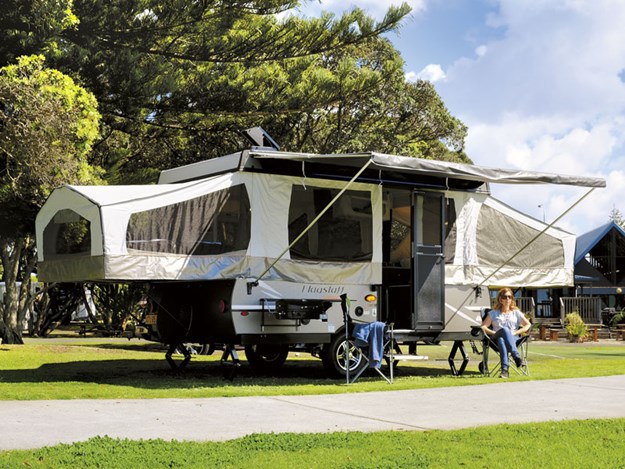
She had seen the odd pop-top camper around and liked the concept, so she searched for something to buy. At that time in New Zealand, few second-hand options were available and next to nothing new. Looking overseas, she was surprised how popular pop-top campers were, particularly in Australia and the United States, and how many options were available.
Lisa found what she wanted in the Forest River range of RVs – the 228D in the Mac Series built by Flagstaff Camping Trailers, an American company established in 1974. In December 2013, I first met Lisa when I reviewed one of her initial Mac imports.
The process of deciding to become a sales agent for Flagstaff, securing the agency and making the first import had taken a couple of years, but Lisa was on her way. Lisa chose the Mac 228D because it offered good value and met her family’s camping needs. Six years later, it is still her best-selling model.
Defining the dream
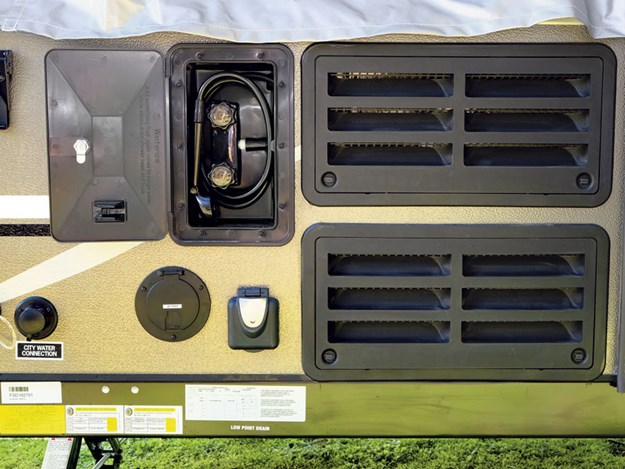 |
The external shower. You can pitch a shower tent in the corner alongside the dinette. |
Like Lisa, those migrating from tenting to something better seek reliable, weatherproof shelter with good headroom, dry storage space, non-damp beds, lighting and easy erecting and dismantling. Highly desirable features are room to eat and entertain, indoor cooking and washing-up, hot pressurised water and a space heater.
Mostly, pop-tops stay at campgrounds so having a shower and toilet inside is not as important, although there are other models with shower and toilet. For Lisa, the Mac 228D ticked all of these boxes. Done deal.
Reality
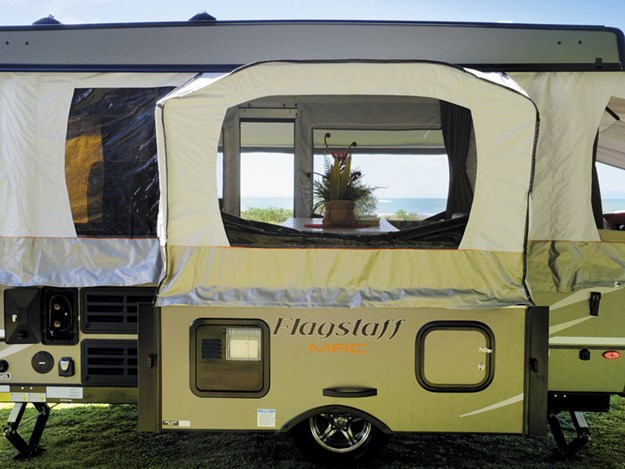 |
With the pop-top raised and beds and dinette extended, the Mac is as big as a medium-sized caravan |
My first impression on entering the Mac was how roomy it was inside. Three slide-outs – a bed at each end and a dinette opposite the entry – create the space. With the slide-outs deployed, the overall length of the trailer box nearly doubles from 3700mm to 7300mm, and the dinette slides out sideways 750mm to clear the centre walkway.
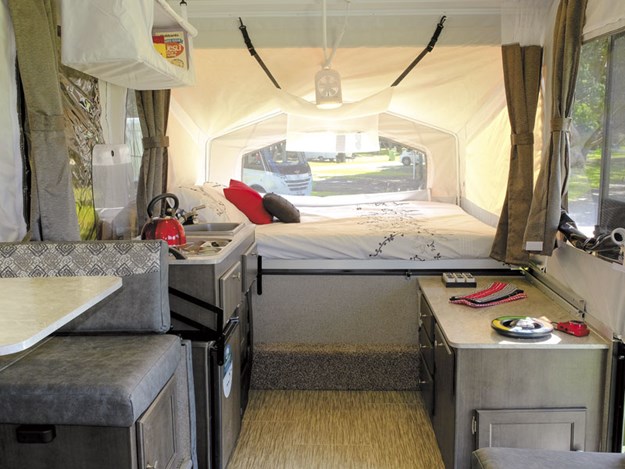 |
Past the galley (left) is the monster-sized rear bed |
The full-width beds are enormous; front 2000mm x 1770mm and rear 2000mm x 1500mm, and they come with a fitted inner-sprung mattress. Making the slide-out beds before leaving home saves storing the bedding elsewhere, and the beds are available for use as soon as the pop-top is raised once you arrive.
Vive la différence
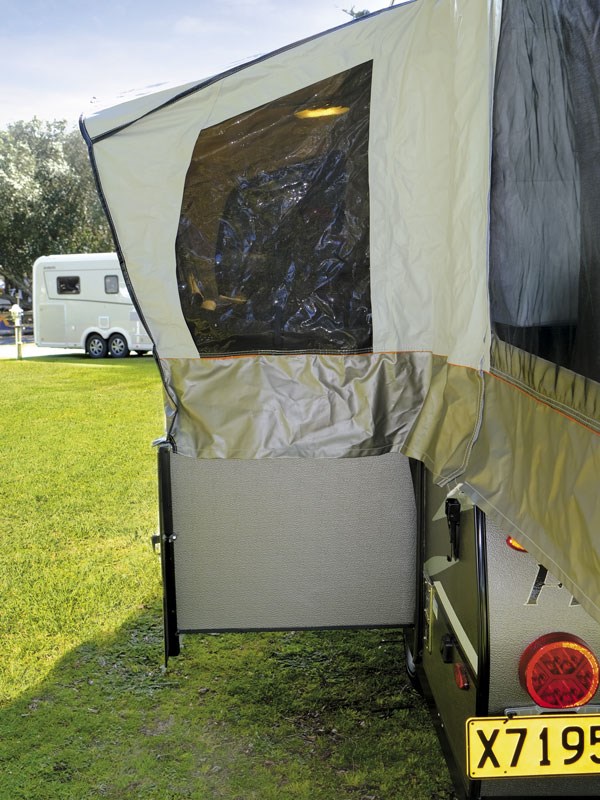 |
The dinette is moved manually saving battery energy |
Excellent headroom throughout the camper and the lack of overhead cupboards contribute to the spacious feeling, but that comes at the expense of storage opportunities. Storage lockers and drawers are located in the galley cabinet, in the cabinet opposite, and under the settee and dinette.
It’s enough for those moving from tents to the pop-top, but anyone coming out of caravans or motorhomes might want more. Stowage nets over and beside the beds and the nifty fabric hanging units, one a pantry and the other a shelf cabinet, offer more storage options and bring a ‘safari’ touch to the interior.
Tucker time
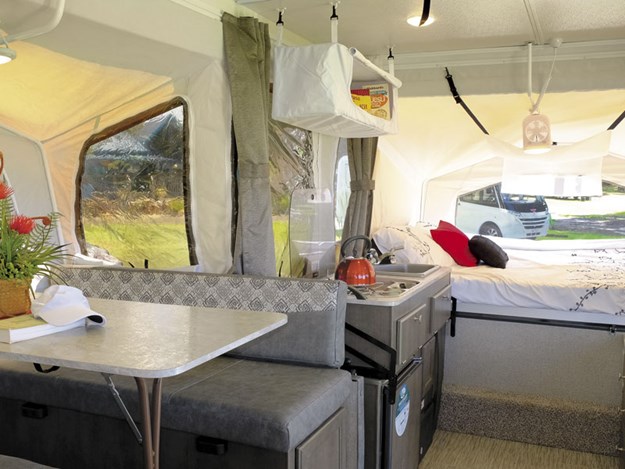 |
Space for six makes the dinette a popular place for socialising |
A genuine six-seat dinette ticks the ‘eat and entertain’ box. While the cushion covers have the look and feel of woven fabric, they are in fact, a durable, easily cleaned and practical vinyl. The seat cushions offer firm seating, the back cushions are angled for correct support, and there is plenty of leg space under the table.
Being freestanding, the dinette table can also be used outside and folded flat and stowed away when not needed. Full house overnight? The dinette converts to a double bed. Opposite the dinette is a 2m-long settee that also converts to a single bed, which means there could be seven for breakfast. That will test the versatility of the dinette if guests all want a seat at the same time.
Hard facts
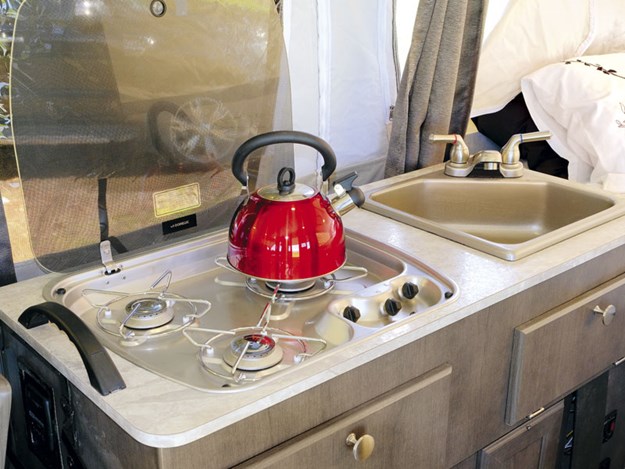 |
Just like home — 3 hobs and sink |
Furniture cabinet heights in pop-tops are dictated by the height of the permanent sidewalls. These are built low to keep the height of the towed pop-top as low as possible, allowing the driver to see rearwards over the trailer when underway. End result; pop-top camper tables have folding legs and benchtops are uncomfortably low.
To solve this, Flagstaff raised the working height by mounting the galley sink and three-burner cooktop unit on swing arms. The galley unit sits on the floor when travelling and the swing arms lighten the load when it is raised to bench height, making things much more convenient.
Hot, cold, pressurised and filtered water are supplied from an underfloor 98-litre tank. A 55-litre three-way fridge is mounted in the cabinet below the hobs. The Mac has more windows than wall space. Each window has its own permanent insect screen on the outside, and most are tinted vinyl with a privacy curtain that zips into place on the inside.
Once in position, each window is waterproof and offers complete privacy. Safety features include a smoke alarm, CO/LPG detector, and a fire extinguisher. Three double, on-the-grid power points are available for radio, TV, and hairdryers and there are two USB ports for charging devices. Four ceiling lights, a removable light over the dinette and a portable fan/light unit supply night-time illumination.
The outside
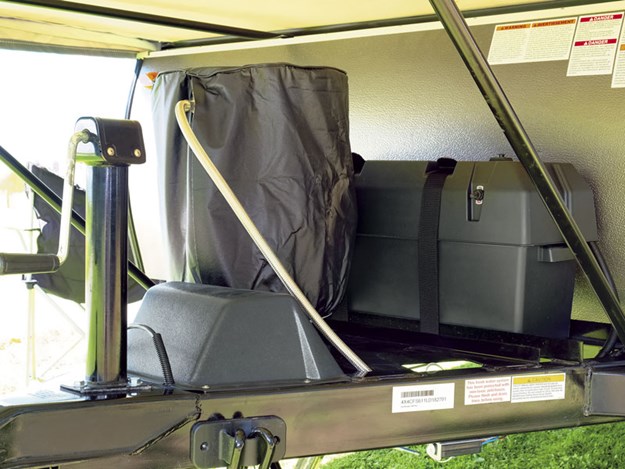 |
Under its nylon cover beside the battery box is the 9kg LPG bottle. Note the pop-top lift handle alongside. |
The fabric wall and roof section are designed and built to cope with American weather conditions, which also makes them functional and durable in New Zealand. Made from Vinolon, a woven synthetic fabric custom-made for the job, the pop-top walls are waterproof and mould-resistant.
Each of the five zip-out wall/roof sections is separate, making it easy and cost-effective if they need replacing. Mac designers and fabricators take special care to ensure rainwater runs off the walls and not into the pop-top. The pop-top roof is fibreglass, vacuum-bonded in one piece. Aluminium cladding is used on the sides of the trailer.
The spare wheel is mounted on the back of the trailer while, upfront on the A-frame, are the 9kg LPG bottle and the battery box. Around the corner, by the dinette slide-out, is a hot/cold external shower. Some Mac owners erect a shower tent by the shower and also keep their portable toilet in the tent.
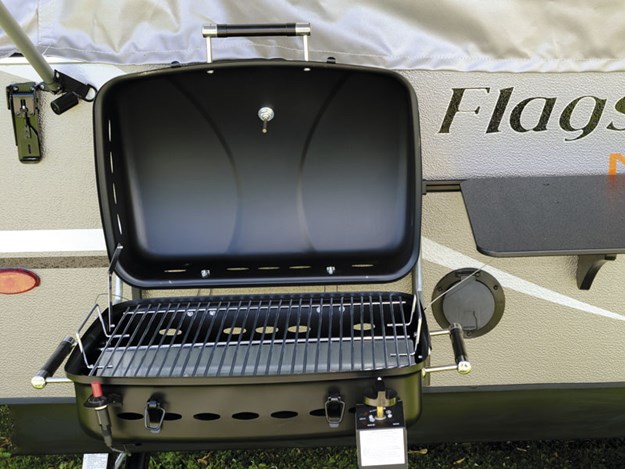 |
Mac’s popular barbecue (I wish it wasn’t so expensive) |
A standard feature on the Mac is the LPG barbecue, with worktop alongside. With a large working surface, compact overall size and fold-down lid, the barbecue attracts a lot of attention at RV shows. If you are one of the many who wanted one, they are for sale – price $35,990 with a Flagstaff Mac thrown in for free.
Each Mac is fitted with a 3500mm roll-out awning that includes privacy panels to enclose the space under the awning. Wall-mounted LED lights illuminate the area under the awning. A foldout entry step and grab rail ease entry to and exit from the camper. A popular optional extra is the bed-end garage.
This fits under the rear slide-out bed, creating a private storage area for bulky kit, such as bikes, surfboards and kids’ toys – out-of-sight/out-of-mind storage that stays safe at most campgrounds. Another popular extra is solar panelling, either fixed panels on the roof or freestanding panels that park on the ground beside the Mac.
Connections to the house battery are installed ready to hook up to solar panels. raising the roof With guidance, raising the roof took me 20 minutes. Packing up took five minutes longer. I was assured familiarity would knock five minutes off those times. For full roof-raising instructions, Flagstaff has loaded a 10-minute instructional video on YouTube.
Behind the scenes
With a GVW of 1480kg, the Mac is well within the towing capacity of many popular sedans and small SUVs. It is high enough to be seen through the rear window of the towing vehicle, making it easier to back up, but low enough to see who and what is behind.
The verdict
The Mac is pretty much unchanged since my MCD review in 2014. What has changed is the basic package. Items previously considered extras (alloy wheels/Pro Rack roof racks/outside shower/ water filtration/23-litre DSI 240-volt hot-water heater) are now included. A two-hour delivery handover is also offered.
There are several different sizes and styles of camper trailers in the Flagstaff range. The Mac 228D is still Lisa’s favourite for the same reasons it was when she started looking. As I said back in 2014, “While it may be possible to achieve similar levels of creature comfort in a tent, it would be a much bigger logistical task than just hitching the Flagstaff Mac to your family car and taking off.”
Pros
- The care taken in manufacture to ensure the canopy remains weatherproof in all conditions
- The headroom and spacious feeling inside
- The comprehensive selection of extras included in the basic package
Cons
- More storage solutions would be good
Flagstaff Mac 228D specifications
| Length: trailer box open/closed | 7300mm/3700mm |
| Length (closed with hitch) | 5200mm |
| Width open/closed | 2900mm/2200mm |
| Height closed | 1450mm (excl roof racks) |
| Interior height | 2030mm |
| Dry hitch weight | 119kg |
| Tare weight | 1106kg (varies according to extras fitted) |
| GVW | 1480kg |
| Payload | 374kg (varies according to extras fitted) |
Fresh water capacity | 98 litres |
Price as reviewed | $35,990 incl gst |
Payload | 1019kg |
Find more motorhomes, RVs and caravans for sale in NZ
Visit poptopcampers.co.nz for more information.





